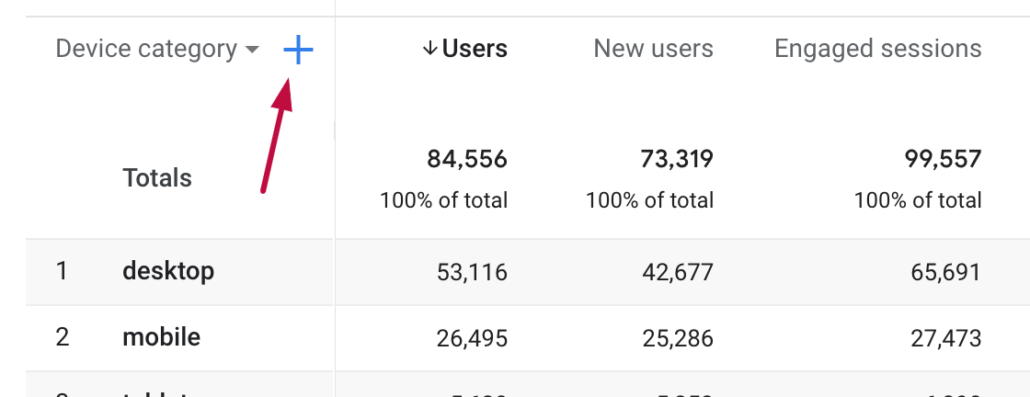Secondary Dimension in Google Analytics: Ideal Practices and Tips
Wiki Article
Enhance Your Data Analysis Using Additional Dimension in Google Analytics
Checking out the capabilities of additional measurements in Google Analytics opens up a world of opportunities for refining data analysis. By layering added dimensions onto primary information sets, a more intricate story emerges, losing light on individual interactions and performance indications.Recognizing Secondary Dimensions
Additional dimensions in Google Analytics refer to extra criteria that can be added to the primary dimension, allowing for a more thorough evaluation of information (Secondary Dimension in Google Analytics). By including secondary measurements, analysts can sector and filter information to uncover patterns, patterns, and relationships that may not be obvious when looking at the data as a whole.
Benefits of Making Use Of Second Measurements
When evaluating information in Google Analytics, the application of secondary dimensions uses invaluable insights into user actions and performance metrics. By adding a secondary dimension to your primary data, you can delve much deeper right into the features of your internet site visitors and their communications. Among the vital benefits of utilizing additional dimensions is the capability to segment and contrast data better. This segmentation enables you to comprehend exactly how various variables, such as demographics or website traffic sources, influence user actions and conversions (Secondary Dimension in Google Analytics).
In addition, secondary dimensions help in determining patterns and connections that may not be promptly obvious when looking at the information in isolation. This deeper level of evaluation can reveal useful information that can guide marketing methods, site optimization, and total business choices. In addition, secondary measurements improve the context of your main data, providing a much more detailed sight of individual involvement and performance metrics. In general, using secondary dimensions in Google Analytics can substantially enhance the deepness and top quality of your data evaluation, resulting in even more informed decision-making and improved outcomes.
Just How to Include Secondary Dimensions
By including second measurements in Google Analytics, users can gain much deeper insights into their information evaluation process, allowing for even more detailed assessment of individual behavior and performance metrics. Adding second measurements is a simple procedure that can significantly enhance the depth of evaluation. To add a second measurement in Google Analytics, begin by browsing to the report you want to evaluate. As soon as in the record, situate the "Secondary measurement" tab above the data table. Click on it to reveal a dropdown menu with various choices such as Actions, Technology, and Custom Dimensions. Select the dimension you want to add, such as 'Source/Medium' or 'Gadget Group'. This secondary dimension will certainly after that be applied to your existing information, giving added context and permitting a much more in-depth evaluation of individual interactions. By using additional dimensions effectively, click site individuals can reveal beneficial understandings that may have or else been neglected, leading to educated decision-making and improved efficiency methods.Analyzing Information With Additional Dimensions
Using additional dimensions in data evaluation offers a much more comprehensive understanding of individual actions and efficiency metrics. By adding a second measurement to your primary information set in Google Analytics, you can delve deeper into the features of your internet site visitors and their interactions. Combining the key measurement of 'source/medium' with the second measurement of 'landing web page' can disclose which particular web pages are attracting website traffic from various resources, assisting you maximize these web pages for better engagement.
In significance, evaluating information with secondary measurements equips you to acquire valuable insights into individual actions, identify fads, and make educated decisions to boost the performance of your digital try this website properties.
Finest Practices for Secondary Measurements
In data analysis, integrating secondary dimensions successfully can considerably improve the depth of understandings stemmed from metrics and individual behavior patterns. When making use of secondary dimensions in Google Analytics or any type of other logical device, it is vital to abide by ideal techniques to ensure the precision and relevance of the data analysis.One trick finest method is to meticulously pick additional dimensions that match the main dimension being analyzed. Picking secondary dimensions that supply added context or more segmentation can use a more extensive understanding of the data. It is additionally important to prevent overcomplicating the evaluation by consisting of a lot of additional measurements, which might bring about confusion or dilution of insights.
Furthermore, it is a good idea to trying out various mixes of secondary and primary dimensions to discover new connections and fads. Frequently refining the choice and examining of additional measurements based upon the particular objectives of the evaluation can lead to more actionable insights. By adhering to these best practices, data analysts can leverage additional measurements successfully to improve the overall data analysis process and decision-making capabilities.

Verdict
In final thought, integrating second measurements in Google Analytics is crucial for a thorough data evaluation technique. By leveraging second measurements alongside main ones, marketing experts and analysts can discover beneficial insights and correlations that can educate decision-making and maximize digital marketing approaches. Comprehending how to efficiently utilize additional article source measurements and following best methods will permit professionals to draw out purposeful data and enhance their general performance metrics.Secondary measurements in Google Analytics refer to extra criteria that can be added to the main measurement, enabling for a more detailed evaluation of information. By including secondary dimensions, experts can segment and filter information to reveal patterns, patterns, and connections that might not be noticeable when looking at the information as a whole. Combining the key measurement of 'source/medium' with the additional dimension of 'touchdown web page' can reveal which specific pages are drawing in traffic from different resources, assisting you enhance these pages for better engagement.
One secret ideal technique is to carefully choose second measurements that complement the key dimension being evaluated. By following these finest techniques, data analysts can utilize additional dimensions effectively to enhance the overall data analysis procedure and decision-making capabilities.
Report this wiki page